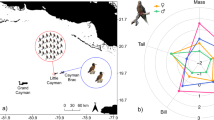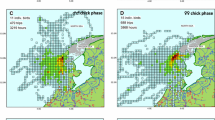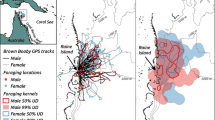Abstract
Sexual segregation in foraging habitats and associated diet differences have been reported in many seabirds. These sexual distinctions can be caused by differences in competitive ability or nutritional requirements. Here, we investigated the diets of male and female Black-tailed Gulls Larus crassirostris by collecting regurgitations during the incubation period and examining foraging behaviours and habitat use via tracking with Global Positioning System data loggers. In both males and females, the regurgitations predominantly contained Japanese Sand Lance Ammodytes personatus. Females were more likely than males to make long foraging trips. Males frequently foraged in fishing ports and fish processing plants; however, females rarely foraged in these locations. Males favoured nearshore areas (< 50 m sea depth), whereas females expanded their foraging range to deeper areas near the ocean frontal zone. The observed sexual segregation in foraging habitat use despite consumption of the same prey might be derived from competitive exclusion by males, which have a larger body size and stronger competitive abilities than females, rather than from different nutritional requirements.
Zusammenfassung
Männliche und weibliche Japanmöwen Larus crassirostris ernähren sich von den gleichen Beutetieren, suchen aber unterschiedliche Orte zur Nahrungssuche auf
Für viele Seevogelarten ist bekannt, dass sie ihre Nahrungshabitate nach Geschlechtern getrennt aufsuchen und dementsprechend unterschiedliche Nahrung zu sich nehmen. Diese Geschlechtsunterschiede könnten an Unterschieden in ihrer Konkurrenzfähigkeit oder ihren Nahrungsbedürfnissen liegen. Wir untersuchten die Nahrung männlicher und weiblicher Japanmöwen (Larus crassirostris), indem wir das während der Brutzeit Ausgewürgte sammelten, die Verhaltensweisen bei der Nahrungsaufnahme analysierten und das Aufsuchen der Nahrungshabitate per GPS Datenlogger auswerteten. Bei Männchen und Weibchen enthielt das Ausgewürgte überwiegend den kleinen Japanischen Sandaal (Ammodytes personatus). Die Weibchen waren eher als die Männchen bereit, zur Nahrungsaufnahme längere Strecken zurückzulegen. Die Männchen suchten ihre Nahrung regelmäßig in Fischerhäfen und bei Fischaufbereitungsanlagen; Weibchen waren dort nur selten zu sehen. Männchen bevorzugten küstennahe Gebiete (< 50 m Wassertiefe), wohingegen die Weibchen den Radius ihrer Nahrungsflüge auf Bereiche mit größerer Wassertiefe ausdehnten. Die von uns beobachtete geschlechtsspezifische Trennung der Nahrungshabitate trotz gleicher Beutetiere könnte eher an unterschiedlichen Nahrungsbedürfnissen als an einem kompetitiven Ausschluss der Männchen liegen, die größer und schwerer sind und stärker ausgeprägte Wettbewerbsfähigkeiten haben.






Similar content being viewed by others
References
Arcos JA, Oro DO (2002) Significance of nocturnal purse seine fisheries for seabirds: a case study off the Ebro Delta (NW Mediterranean). Mar Biol 141:277–286
Arcos JA, Oro DO, Sol D (2001) Competition between the Yellow-legged Gull Larus cachinnans and Audouin’s Gull Larus audouinii associated with commercial fishing vessels: the influence of season and fishing fleet. Mar Biol 139:807–816
Awkerman JA, Fukuda A, Higuchi H, Anderson DJ (2005) Foraging activity and submesoscale habitat use of Waved Albatrosses Phoebastria irrorata during chick-brooding period. Mar Ecol Prog Ser 291:289–300
Bartoń K (2015) MuMIn: multi-model inference. R package version 1:13
Bates D, Maechler M, Bolker B, Walker S (2014) lme4: linear mixed-effects models using Eigen and S4. R package version 1:1–23
Bécares J, García-Tarrasón M, Villero D, Bateman S, Jover L, García-Matarranz V, Sanpera C, Arcos JM (2015) Modelling terrestrial and marine foraging habitats in breeding Audouin’s Gulls Larus audouinii: timing matters. PLoS One 10:e0120799
Burger J (1981) Sexual differences in parental activities of breeding Black Skimmers. Am Nat 117:975–984
Burger J, Staine S (1993) Nocturnal behavior of gulls in coastal New Jersey. Estuar Coast 16:809–814
Burnham KP, Anderson DR (2003) Model selection and multimodel inference: a practical information-theoretic approach. Springer, Berlin
Camphuysen KCJ, Shamoun-Baranes J, van Loon EE, Bouten W (2015) Sexually distinct foraging strategies in an omnivorous seabird. Mar Biol 162:1417–1428
Catry P, Phillips RA, Croxall JP, Ruckstuhl K, Neuhaus P (2006) Sexual segregation in birds: patterns, processes and implications for conservation. In: Ruckstuhl K (eds) Sexual segregation in vertebrates. Cambridge University Press, Cambridge, pp 351–378
Chochi M, Niizuma Y, Takagi M (2002) Sexual differences in the external measurements of Black-tailed Gulls breeding on Rishiri Island, Japan. Ornithol Sci 1:163–166
Cleasby IR, Wakefield ED, Bodey TW, Davies RD, Patrick SC, Newton J, Votier SC, Bearhop S, Hamer KC (2015) Sexual segregation in a wide-ranging marine predator is a consequence of habitat selection. Mar Ecol Prog Ser 518:1–12
Deguchi T, Watanuki Y, Niizuma Y, Nakata A (2004) Interannual variations of the occurrence of epipelagic fish in the diets of the seabirds breeding on Teuri Island, northern Hokkaido, Japan. Prog Oceanogr 61:267–275
Elliott KH, Gaston AJ, Crump D (2010) Sex-specific behavior by a monomorphic seabird represents risk partitioning. Behav Ecol 21:1024–1032
Freed LA (1981) Loss of mass in breeding wrens: stress or adaptation? Ecology 62:1179–1186
Furness RW, Ensor K, Hudson AV (1992) The use of fishery waste by gull populations around the British Isles. Ardea 80:105–113
García-Tarrasón M, Bécares J, Bateman S, Arcos JM, Jover L, Sanpera C (2015) Sex-specific foraging behavior in response to fishing activities in a threatened seabird. Ecol Evol 5:2348–2358
Garthe S, Hüppop O (1996) Nocturnal Scavenging by gulls in the Southern North Sea. Colon Waterbirds 19:232–241
González-Solís J, Croxall JP, Wood AG (2000) Sexual dimorphism and sexual segregation in foraging strategies of Northern Giant Petrels, Macronectes halli, during incubation. Oikos 90:390–398
Hatch SA (1987) Copulation and mate guarding in the Northern Fulmar. Auk 104:450–461
Hokkaido Government Soya General Subprefectural Bureau (2017) Agriculture of Soya sub-prefecture. http://www.souya.pref.hokkaido.lg.jp/ss/num/souya_nougyou.htm. Accessed 28 Oct 2017 (in Japanese)
Hokkaido National Fisheries Research Institute (2017) Assessment of stock size of Japanese Sand Lance on Soya Straits in 2016. http://abchan.fra.go.jp/digests28/details/2851.pdf. Accessed 28 Oct 2017 (in Japanese)
Isaksson N, EvansTJ Shamoun-Baranes J, Åkesson S (2016) Land or sea? Foraging area choice during breeding by an omnivorous gull. Mov Ecol 4:11
Kazama K, Tomita N, Ito M, Niizuma Y (2008) Responses in breeding behaviour of the Black-tailed Gull (Larus crassirostris) to different marine environments. In: Okada H, Mawatari SF, Suzuki N, Gautam P (eds) Proceedings of International Symposium “The Origin and Evolution of Natural diversity”, 1–5 October 2007, Sapporo. 21st Century COE for Neo-Science of Natural History, Hokkaido University, Sapporo. pp 215–220
Kazama K, Niizuma Y, Sakamoto KQ, Watanuki Y (2011) Factors affecting individual variation in nest-defense intensity in colonially breeding Black-tailed Gulls (Larus crassirostris). Can J Zool 89:938–944
Kazama K, Niizuma Y, Watanuki Y (2012) Consistent individual variations in aggressiveness and a behavioral syndrome across breeding contexts in different environments in the Black-tailed Gull. J Ethol 30:279–288
Kazama K, Sato M, Kosugi K (2016) Annual variation in breeding numbers of two gull species in response to regional stock size and local availability of Japanese Sand Lance on Rishiri Island, Northern Japan. Ornithol Sci 15:85–94
Lewis S, Benvenuti S, Dall’Antonia L, Griffiths R, Money L, Sherratt TN, Wanless S, Hamer KC (2002) Sex-specific foraging behaviour in a monomorphic seabird. Proc R Soc Lond B Biol Sci 269:1687–1693
Ludynia K, Dehnhard N, Poisbleau M, Demongin L, Masello JF, Voigt CC, Quillfeldt P (2013) Sexual segregation in Rockhopper Penguins during incubation. Anim Behav 85:255–267
Masello JF, Wikelski M, Voigt CC, Quillfeldt P (2013) Distribution patterns predict individual specialization in the diet of Dolphin Gulls. PLoS One 8:e67714
Matsumoto S, Yamamoto T, Yamamoto M, Zavalaga CB, Yoda K (2017) Sex-related differences in the foraging movement of Streaked Shearwaters Calonectris leucomelas breeding on Awashima Island in the sea of Japan. Ornithol Sci 16:23–32
Matsuyama M, Wadaka M, Abe T, Aota M, Koike Y (2006) Current structure and volume transport of the Soya Warm Current in summer. J Oceanogr 62:197–205
Moreno R, Jover L, Munilla I, Velando A, Sanpera C (2010) A three-isotope approach to disentangling the diet of a generalist consumer: the Yellow-legged Gull in northwest Spain. Mar Biol 157:545–553
Mustapha MA, Sei-Ichi S, Lihan T (2009) Satellite-measured seasonal variations in primary production in the scallop-farming region of the Okhotsk Sea. ICES J Mar Sci 66:1557–1569
Mustapha MA, Lihan T, Tangang F, Saitoh S (2015) Identification of biophysical regions in the south-western part of the Okhotsk Sea by satellite imagery classification. Cont Shelf Res 96:16–26
Narita K, Narita A (2004) Observation reports of Black-tailed Gull. Kimura-Shoten, Hachinohe (in Japanese)
Navarro J, González-Solís J (2007) Experimental increase of flying costs in a pelagic seabird: effects on foraging strategies, nutritional state and chick condition. Oecologia 151:150–160
Navarro J, Oro D, Bertolero A, Genovart M, Delgado A, Forero MG (2010) Age and sexual differences in the exploitation of two anthropogenic food resources for an opportunistic seabird. Mar Biol 157:2453–2459
Navarro J, Grémillet D, Afán I, Ramírez F, Bouten W, Forero MG (2016) Feathered detectives: real-time GPS tracking of scavenging gulls pinpoints illegal waste dumping. PLoS One 11:e0159974
Pack W-K, Yoo J-C (1996) Time budgets of the Black-tailed Gull, Larus crassirostris, in the daytime of the breeding season. Korean J Ornithol 3:1–9
Page B, McKenzie J, Goldsworthy SD (2005) Inter-sexual differences in New Zealand Fur Seal diving behaviour. Mar Ecol Prog Ser 304:249–264
Phillips RA, Xavier JC, Croxall JP, Burger AE (2003) Effects of satellite transmitters on albatrosses and petrels. Auk 120:1082–1090
Phillips RA, Silk JRD, Phalan B, Catry P, Croxall JP (2004) Seasonal sexual segregation in two Thalassarche albatross species: competitive exclusion, reproductive role specialization or foraging niche divergence? Proc R Soc Lond B Biol Sci 217:1283–1291
Pinet P, Jaquemet S, Phillips RA, Le Corre M (2012) Sex-specific foraging strategies throughout the breeding season in a tropical, sexually monomorphic small petrel. Anim Behav 83:979–989
R Core Team (2016) R: a language and environment for statistical computing. R Foundation for Statistical Computing, Vienna
Ramírez F, Navarro J, Afan I, Hobson KA, Delgado A, Forero MG (2012) Adapting to a changing world: unraveling the role of man-made habitats as alternative feeding areas for Slender-billed Gull (Chroicocephalus genei). PLoS One 7:e47551
Ramos R, Ramirez F, Sanpera C, Jover L, Ruiz X (2009) Diet of Yellow-legged Gull (Larus michahellis) chicks along the Spanish Western Mediterranean coast: the relevance of refuse dumps. J Ornithol 150:265–272
Robards MD, Willson MF, Armstrong RH, Piatt JF (2000) Sand Lance: a review of biology and predator relations and annotated bibliography. Department of Agriculture, Forest Service, Pacific Northwest Research Station, Portland
Rock P, Camphuysen CJ, Shamoun-Baranes J, Ross-Smith VH, Vaughan IP (2016) Results from the first GPS tracking of roof-nesting Herring Gulls Larus argentatus in the UK. Ring Migr 31:47–62
Ruckstuhl K, Neuhaus P (2005) Sexual segregation in vertebrates: ecology of the two sexes. Cambridge University Press, Cambridge
Székely T, Reynolds JD, Figuerola J (2000) Sexual size dimorphism in shorebirds, gulls, and alcids: the influence of sexual and natural selection. Evolution 54:1404–1413
Thaxter CB, Daunt F, Hamer KC, Watanuki Y, Harris MP, Grémillet D, Peters G, Wanless S (2009) Sex-specific food provisioning in a monomorphic seabird, the common guillemot Uria aalge: nest defence, foraging efficiency or parental effort? J Avian Biol 40:75–84
Villablanca R, Luna-Jorquera G, Marín VH, Garthe S, Simeone A (2007) How does a generalist seabird species use its marine habitat? The case of the Kelp Gull in a coastal upwelling area of the Humboldt Current. ICES J Mar Sci 64:1348–1355
Wakkanai City office (2017) District of Wakkanai city planning area. (http://www.city.wakkanai.hokkaido.jp/sangyo/toshikeikaku/keikaku/wakkanai_toshikeikaku_tiiki.html. Accessed 28 Oct 2017 (in Japanese)
Wearmouth VJ, Sims DW (2008) Sexual segregation in marine fish, reptiles, birds and mammals: behaviour patterns, mechanisms and conservation implications. Adv Mar Biol 54:107–170
Weimerskirch H (2007) Are seabirds foraging for unpredictable resources? Deep Sea Res II 54:211–223
Weimerskirch H, Salamolard M, Sarrazin F, Jouventin P (1993) Foraging strategy of Wandering Albatrosses through the breeding season: a study using satellite telemetry. Auk 110:325–342
Weimerskirch H, Shaffer SA, Tremblay Y, Costa DP, Gadenne H, Ropert-Coudert Y, Sato K, Aurioles D (2009) Species- and sex-specific differences in foraging behaviour and foraging zones in Blue-footed and Brown Boobies in the Gulf of California. Mar Ecol Prog Ser 391:267–278
Wood SN (2015) Package ‘mgcv’. R package version, pp 1–7
Worton BJ (1989) Kernel methods for estimating the utilization distribution in home-range studies. Ecol 70:164–168
Yamamoto T, Takahashi A, Oka N, Iida T, Katsumata N, Sato K, Trathan PN (2011) Foraging areas of Streaked Shearwaters in relation to seasonal changes in the marine environment of the Northwestern Pacific: inter-colony and sex-related differences. Mar Ecol Prog Ser 424:191–204
Yamamoto T, Hoshina K, Nishizawa B, Meathrel CE, Phillips RA, Watanuki Y (2015a) Annual and seasonal movements of migrating Short-tailed Shearwaters reflect environmental variation in sub-Arctic and Arctic waters. Mar Biol 162:413–424
Yamamoto T, Watanuki Y, Hazen EL, Nishizawa B, Sasaki H, Takahashi A (2015b) Statistical integration of tracking and vessel survey data to incorporate life history differences in habitat models. Ecol Appl 25:2394–2406
Yoda K, Tomita N, Mizutani Y, Narita A, Niizuma Y (2012) Spatio-temporal responses of Black-tailed Gulls to natural and anthropogenic food resources. Mar Ecol Prog Ser 466:249–259
Acknowledgements
We thank Kazuki Kosugi, Masahiko Sato, Rie Sato, Toru Nishijima, Kanako Nishijima, Kazuki Nishijima, and Shinya Okada for their support and assistance in the field. We are grateful to Franz Bairlein and two anonymous referees for their very helpful comments and suggestions that improved the manuscript. Hokkaido Soya sub-prefectural office gave us permission (no. 452-43 ~ 48) to work on the Black-tailed Gulls in the study areas on Rishiri Island. This study was supported by the Environment Research and Technology Development Fund (4-1603) of the Environmental Restoration and Conservation Agency, Japan.
Author information
Authors and Affiliations
Corresponding author
Additional information
Communicated by C. Barbraud.
Electronic supplementary material
Below is the link to the electronic supplementary material.
Rights and permissions
About this article
Cite this article
Kazama, K., Nishizawa, B., Tsukamoto, S. et al. Male and female Black-tailed Gulls Larus crassirostris feed on the same prey species but use different feeding habitats. J Ornithol 159, 923–934 (2018). https://doi.org/10.1007/s10336-018-1565-9
Received:
Revised:
Accepted:
Published:
Issue Date:
DOI: https://doi.org/10.1007/s10336-018-1565-9




